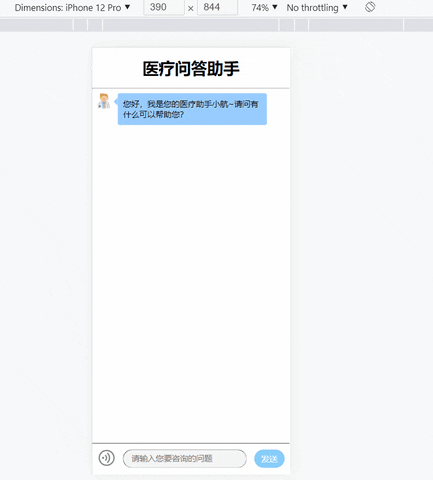医疗问答机器人项目部署
文章目录
这是去年8月份做的项目,当时我参加了南航16院卓工班的实训,是做了一个智能医疗系统,其中包含了这个医疗问答助手功能。由于当时受限于时间和知识水平,当时的问答助手的功能较为简单,可以理解为是基于规则的问答系统,不能算真正意义上的智能。故在今年年初的时候再完善一下这个项目,使用NLP领域的一些算法使其更符合实际使用。
1. 拉取TensorFlow镜像
从Docker Hub拉取TensorFlow的镜像,在该镜像上进行下面的操作。
# 拉取镜像
$ docker pull tensorflow/tensorflow:1.14.0-py3
# 生成容器
$ docker run -dit --name diagnosis -p 5002:5002 -p 7474:7474 -p 7473:7473 -p 7687:7687 -p 60061:60061 -p 60062:60062 tensorflow/tensorflow:1.14.0-py3
# 进入容器
$ docker exec -it diagnosis bash
5002端口是项目端口;7473、7474和7687三个端口是neo4j的端口;60061和60062是另外两个服务的端口。
查看容器tensorflow的版本和gpu是否可用,进入python终端输入下面的指令,可以看到使用的tensorflow版本是1.14.0。
>>> import tensorflow as tf
>>> tf.__version__
'1.14.0'
>>>tf.test.is_gpu_available()
False
2. 配置系统环境
查看Ubuntu版本,即18.04.2版本。
root@322e47635519:/workspace/Diagnosis-Chatbot# cat /etc/issue
Ubuntu 18.04.2 LTS \n \l
2.1 更换软件源
先备份原有的软件源,命令如下。
cp /etc/apt/sources.list /etc/apt/sources.list.bak
因为镜像没有安装vim,故只能通过echo指令更改/etc/apt/sources.list文件内容。
阿里源
echo "">/etc/apt/sources.list
echo "deb http://mirrors.aliyun.com/ubuntu/ bionic main restricted universe multiverse">>/etc/apt/sources.list
echo "deb http://mirrors.aliyun.com/ubuntu/ bionic-security main restricted universe multiverse">>/etc/apt/sources.list
echo "deb http://mirrors.aliyun.com/ubuntu/ bionic-updates main restricted universe multiverse">>/etc/apt/sources.list
echo "deb http://mirrors.aliyun.com/ubuntu/ bionic-proposed main restricted universe multiverse">>/etc/apt/sources.list
echo "deb http://mirrors.aliyun.com/ubuntu/ bionic-backports main restricted universe multiverse">>/etc/apt/sources.list
echo "deb-src http://mirrors.aliyun.com/ubuntu/ bionic main restricted universe multiverse">>/etc/apt/sources.list
echo "deb-src http://mirrors.aliyun.com/ubuntu/ bionic-security main restricted universe multiverse">>/etc/apt/sources.list
echo "deb-src http://mirrors.aliyun.com/ubuntu/ bionic-updates main restricted universe multiverse">>/etc/apt/sources.list
echo "deb-src http://mirrors.aliyun.com/ubuntu/ bionic-proposed main restricted universe multiverse">>/etc/apt/sources.list
echo "deb-src http://mirrors.aliyun.com/ubuntu/ bionic-backports main restricted universe multiverse">>/etc/apt/sources.list
更新软件源。
apt-get update
apt-get upgrade
在更换软件源时,我首先使用的是清华源,但是在下载vim时提示说不能下载vim相关的一些依赖。在网上搜索后应该是源的问题,后来我就更换为阿里源了。
2.2 下载vim
修改文件内容需要使用vim,所以要下载。
apt-get install vim -y
下载完成后可以通过下面的指令查看vim的版本。
vim --version
2.3 解决vim中文乱码问题
修改/etc/vim/vimrc内容,在最后面添加下面的内容:
set fileencodings=utf-8,ucs-bom,gb18030,gbk,gb2312,cp936
set termencoding=utf-8
set encoding=utf-8
设置后文件内的中文就可以正常显示了。
2.4 安装Neo4J图数据库
详细步骤可以看我的另外一篇博客—在Linux系统下安装Neo4j图数据库。
2.5 安装网络工具包
apt-get install inetutils-ping
apt-get install net-tools
3. 运行项目
3.1 拷贝项目到容器中
首先在容器中创建workspace目录,将项目代码放入到该目录下。
root@322e47635519:/# mkdir workspace
将本机上的项目代码文件拷贝到容器的工作目录下。
$ docker cp "本机上项目的路径" diagnosis:/workspace/
上面的指令实现的功能是,将项目拷贝到diagnosis容器中的/workspace/目录下。
3.2 安装项目所需的工具包
首先要升级pip,升级指令如下。
pip install -i https://pypi.tuna.tsinghua.edu.cn/simple --upgrade pip
使用pip指令下载工具包,-i后面使用的清华源,最后是工具包的名称。
pip install -i https://pypi.tuna.tsinghua.edu.cn/simple packageName
在该容器中,我需要安装的包如下:
# 导入Neo4j数据库
pip install -i https://pypi.tuna.tsinghua.edu.cn/simple py2neo==2021.2.3
pip install -i https://pypi.tuna.tsinghua.edu.cn/simple pandas==1.1.5
pip install -i https://pypi.tuna.tsinghua.edu.cn/simple tqdm==4.62.3
# 启动问答助手服务
pip install -i https://pypi.tuna.tsinghua.edu.cn/simple numpy==1.19.5
pip install -i https://pypi.tuna.tsinghua.edu.cn/simple flask==1.1.4
pip install -i https://pypi.tuna.tsinghua.edu.cn/simple flask_cors==3.0.10
pip install -i https://pypi.tuna.tsinghua.edu.cn/simple scikit-learn==0.24.1
pip install -i https://pypi.tuna.tsinghua.edu.cn/simple requests==2.26.0
# bilstm算法
pip install -i https://pypi.tuna.tsinghua.edu.cn/simple pyahocorasick==1.4.2
pip install -i https://pypi.tuna.tsinghua.edu.cn/simple gevent==1.5.0
# 意图识别
pip install -i https://pypi.tuna.tsinghua.edu.cn/simple bert4keras==0.10.8
# 语音识别
pip install -i https://pypi.tuna.tsinghua.edu.cn/simple huggingface_hub==0.0.6
pip install -i https://pypi.tuna.tsinghua.edu.cn/simple hyperpyyaml==0.0.1
pip install -i https://pypi.tuna.tsinghua.edu.cn/simple joblib==0.14.1
pip install -i https://pypi.tuna.tsinghua.edu.cn/simple pre-commit==2.3.0
pip install -i https://pypi.tuna.tsinghua.edu.cn/simple sentencepiece==0.1.91
pip install -i https://pypi.tuna.tsinghua.edu.cn/simple SoundFile==0.10.2
pip install -i https://pypi.tuna.tsinghua.edu.cn/simple torch==1.8.0
pip install -i https://pypi.tuna.tsinghua.edu.cn/simple torchaudio==0.8.0
在启动服务的时候报错了:OSError: sndfile library not found。报错原因是因为缺少libsndfile,需要安装,安装指令如下。
$ apt-get install libsndfile1
3.3 导入数据
首先打开容器中的Neo4j服务。
neo4j start
在项目中有个build_kg文件夹,进入到该文件夹中,执行build_kg_utils.py程序即可将数据导入Neo4j数据库中。
$ python build_kg_utils.py
这个过程要等上几个小时。

3.4 打开实体抽取服务
在项目根目录中的knowledge_extraction\bilstm下存放着BiLSTM算法的代码,需要启动该服务。
$ python app.py
因为是使用别人写好的算法代码,在启动时提示版本不兼容的问题,原作者使用的是tensorflow1.0版本,在很多地方上写法不一致,故在此记录。
首先在app.py中需要修改以下代码:
| 旧代码 | 新代码 |
|---|---|
| config = tf.ConfigProto() | config = tf.compat.v1.ConfigProto() |
| sess = tf.Session(config=config) | sess = tf.compat.v1.Session(config=config) |
| graph = tf.get_default_graph() | graph = tf.compat.v1.get_default_graph() |
config = tf.ConfigProto() => config = tf.compat.v1.ConfigProto()
sess = tf.Session(config=config) => sess = tf.compat.v1.Session(config=config)
graph = tf.get_default_graph() => graph = tf.compat.v1.get_default_graph()
3.5 打开意图识别服务
在项目根目录中的nlu\intent_recg_bert下存放着使用Bert模型的意图识别算法的代码,需要启动该服务。
$ python app.py
因为是使用别人写好的算法代码,在启动时提示版本不兼容的问题,原作者使用的是tensorflow1.0版本,在很多地方上写法不一致,故在此记录。
首先在app.py中需要修改以下代码:
| 旧代码 | 新代码 |
|---|---|
| config = tf.ConfigProto() | config = tf.compat.v1.ConfigProto() |
| sess = tf.Session(config=config) | sess = tf.compat.v1.Session(config=config) |
| graph = tf.get_default_graph() | graph = tf.compat.v1.get_default_graph() |
config = tf.ConfigProto() => config = tf.compat.v1.ConfigProto()
sess = tf.Session(config=config) => sess = tf.compat.v1.Session(config=config)
graph = tf.get_default_graph() => graph = tf.compat.v1.get_default_graph()
3.6 打开问答助手服务
在app.py中需要检查主机号和端口号,主机号要写成0.0.0.0不然本机打不开项目,如果端口号要和创建容器时映射的端口一致(这里我设置了5002)。而且要关闭调试模式。
app.run(host='0.0.0.0', port=5002, debug=False, threaded=True)
在完成以上的操作后,在终端中输入如下指令启动项目:
$ python app.py
3.7 效果展示
netstat可以列出正在侦听的所有TCP或UDP端口,包括使用端口和套接字状态的服务。
$ netstat -tunlp
Active Internet connections (only servers)
Proto Recv-Q Send-Q Local Address Foreign Address State PID/Program name
tcp 0 0 0.0.0.0:7687 0.0.0.0:* LISTEN 1241/java
tcp 0 0 0.0.0.0:5002 0.0.0.0:* LISTEN 1727/python
tcp 0 0 0.0.0.0:7474 0.0.0.0:* LISTEN 1241/java
tcp 0 0 127.0.0.1:60061 0.0.0.0:* LISTEN 1753/python
tcp 0 0 127.0.0.1:60062 0.0.0.0:* LISTEN 1779/python
- -t:显示 TCP 端口
- -u:显示 UDP 端口
- -n:显示数字地址而不是主机名
- -l:仅显示侦听端口
- -p:显示进程的 PID 和名称
这时在本机的浏览器上输入localhost:5002即可成功打开项目页面了!

4. 搭建项目镜像
现在把项目所在的容器封装成镜像,方便不同系统上的部署。这里我采用两种方法搭建,分别是Docker commit和Dockerfile搭建项目镜像。
4.1 Docker commit搭建
在Docker中,镜像是多层存储,每一层是在前一层的基础上进行的修改;而容器同样也是多层存储,是在以镜像为基础层,在其基础上加一层作为容器运行时的存储层。
在该项目中,我们是在tensorflow镜像的基础上创建了diagnosis这个容器,并在该容器中进行了修改操作。可以通过 docker diff 命令看到具体的改动。
$ docker diff CONTAINER
docker commit 命令可以将容器的存储层保存下来成为镜像。换句话说,就是在原有镜像的基础上,再叠加上容器的存储层,并构成新的镜像。docker commit 的语法格式为:
$ docker commit [选项] <容器ID或容器名> [<仓库名>[:<标签>]]
在该项目中,我使用如下的指令构建项目镜像:
$ docker commit --author "xxxx" --message "Diagnosis Chatbot Project" diagnosis username/image:tag
其中 --author 是指定作者,而 --message 则是记录本次修改的内容。这点和 git 版本控制相似,不过这里这些信息也可以省略不写。需要注意的是仓库名必须是小写。
用docker image ls指令可以查看我们新创建的镜像。
使用docker run指令可以根据项目镜像生成项目容器,该容器已经配置好环境了,在容器中直接启动服务即可。
4.2 Dockerfile搭建
后续会计划打算用Dockerfile构建这个项目的镜像。
5. 发布项目镜像
将有Docker commit搭建好的项目镜像推送到远端仓库中,指令如下:
$ docker push username/image:tag








 本文详细记录了在一个Docker容器中部署医疗问答机器人的过程,包括拉取TensorFlow镜像、配置系统环境、安装Neo4J数据库、下载所需工具包、导入数据、启动服务等步骤。在部署过程中,解决了Vim中文乱码问题,并针对TensorFlow版本不兼容问题进行了代码修改。最终,通过Dockercommit和Dockerfile两种方式打包项目镜像,以便于在不同环境中快速部署。
本文详细记录了在一个Docker容器中部署医疗问答机器人的过程,包括拉取TensorFlow镜像、配置系统环境、安装Neo4J数据库、下载所需工具包、导入数据、启动服务等步骤。在部署过程中,解决了Vim中文乱码问题,并针对TensorFlow版本不兼容问题进行了代码修改。最终,通过Dockercommit和Dockerfile两种方式打包项目镜像,以便于在不同环境中快速部署。

















 1467
1467

 被折叠的 条评论
为什么被折叠?
被折叠的 条评论
为什么被折叠?










